The Classic of Changes
TRANSLATIONS FROM THE ASIAN CLASSICS
The Classic of Changes
A New Translation of the I Ching as Interpreted by Wang Bi
Translated by
Richard John Lynn
Columbia University Press
New York
Columbia University Press
New York Chichester , West Sussex
cup.columbia.edu
Copyright 1994 Columbia University Press
All rights reserved
E-ISBN 978-0-231-51405-7
Library of Congress Cataloging-in-Publication Data
I ching. English
The classic of changes : a new translation of the I Ching as interpreted by Wang Bi / translated by Richard John Lynn.
p. cm. (Translations from the Asian classics)
Includes bibliographical references.
ISBN 978-0-231-08294-5 (cloth : alk. paper)
ISBN 978-0-231-08295-2 (pbk. : alk. paper)
I. Lynn, Richard John. II. Wang, Bi, 226249. III. Title. IV. Series.
PL2478.D48 1994
299'.51282dc2o
9343999
CIP
A Columbia University Press E-book.
CUP would be pleased to hear about your reading experience with this e-book at .
TRANSLATIONS FROM THE ASIAN CLASSICS
EDITORIAL BOARD
William Theodore de Bary, Chairman
Paul Anderer
Irene Bloom
Donald Keene
George A. Saliba
Haruo Shirane
David D. Wang
Burton Watson
Philip Yampolsky
Contents
The idea to prepare a new English version of the Book of Changes originally came some years ago from Bonnie Crown, director of International Literature and Arts in New York, who also provided much assistance in planning the venture in its earlier stages. She convinced me that a new version was needed, that it would find an audience, and that I was the person to do it. Initially, I was skeptical on all counts and reluctant to get involved in such a complex and massive research and translation project, something that then was rather far removed from the usual areas of my scholarly work. Now that the book is finished, I thank her for all that good advice and encouragement, without which it would never have happened. David Knechtges and Kidder Smith served as readers of the manuscript for Columbia University Press; their reports contained numerous helpful suggestions, many of which I was able to incorporate into the amended and corrected version. I am grateful for their comments and criticism. I also thank Sarah St. Onge for her fine contribution as manuscript editor. Her unflagging energy and zeal for consistency and clarity greatly improved the manuscript, and the patience and good humor she showed in carrying out this complicated and demanding task was most remarkable and very welcome.
The Classic of Changes ( Yijing ) or Changes of the Zhou ( Zhouyi ) was originally a divination manual, which later gradually acquired the status of a book of wisdom. It consists of sixty-four hexagrams () arranged one atop the other in vertical sequence and read from bottom to top. Each line is either solid (yang

) or broken (yin

). For example, Hexagram 59, Huan (Dispersion), is represented with the hexagram

: First Yin, Second Yang, Third Yin, Fourth Yin, Fifth Yang, Top Yangthe bottom trigram being Kan

and the top trigram being Sun

. The combinations are determined by the numerical manipulation of divining sticks, originally yarrow stalks ( A chillea millefolium , also known as milfoil ) or, later, by the casting of coins. In the translation, each hexagram graph or schema appears at the head of the section devoted to the particular hexagram, immediately below the hexagram number.
It is likely that, by the time the Changes was put together as a coherent text in the ninth century B.C. , hexagram divination had already changed from a method of consulting and influencing gods, spirits, and ancestorsthe powerful deadto a method of penetrating moments of the cosmic order to learn how the Way or Dao is configured and what direction it takes at such moments and to determine what ones own place is and should be in the scheme of things. By doing so, one could avert wrong decisions, avoid failure, and escape misfortune and, on the other hand, make right decisions, achieve success, and garner good fortune. What exactly the Dao was in the thought of traditional Chinaat different times and with different thinkersis a complex question. It was generally held throughout traditional Chinese society that Heaven was good and that human beings lived in a morally good universehowever it operated. Beyond that, it can only be said that a spectrum of opinion existed, at one end of which, the Daoespecially when it was understood as the manifestation of the will of Heavenwas seen as an unconscious and impersonal cosmic order that operated purely mechanistically, and, at the other, as something with a consciousness that heeded the plights of both humankind as a whole and the individual in particular and could answer collective and individual pleas for help and comfort. Although intellectual, elite culture tended to hold to the former view and popular culture favored the latter, much ambivalence concerning this issue can be found in the writings of many a sophisticated thinker.
Each hexagram is accompanied by a hexagram name (guaming), a hexagram statement (guaci) or Judgment (tuan), and line statements (yaoci) for each of the six lines. The line statements have a sequential or associational organization based on the general topic given in the Judgment; each states a specific, differentiated instance or variation of the topic, which in complete line statements (many statements seem to be fragments) is followed by a charge or injunction that one should take some action or refrain from it and a final determination (misfortune, good fortune, etc.).
The hexagrams, hexagram statements or Judgments, and line statements are the oldest parts of the Changes . The names and statements probably date from the ninth century B.C. the hexagrams themselves may be much olderand constitute the first layer in what appears to be a three-layered text. The second layer consists of another two parts: commentary on the Judgments called Tuanzhuan and commentary on the abstract meanings or Images (xiang) of the Judgments and the line statements called Xiangzhuan. The Judgments have Great Images (Daxiang)the abstract meanings of hexagrams as whole entitiesand the line statements have Little Images (Xiaoxiang)the abstract meanings of individual lines.
The traditional format of the Changes divides the Tuanzhuan and the Xiangzhuan each into two sections; together, they form the first four of the so-called Ten Wings (Shiyi) of the exegetical material included in the Classic of Changes . All Ten Wings are traditionally attributed to Confucius (551479 B.C. ); however, individual Wings actually date from different periods, with some predating his time while others date from as late as the third century B.C. Only the Commentaries on the Judgments and Commentaries on the Images, which for the most part seem to date from the sixth or fifth century B.C. , appear to have been the direct product of Confuciuss school, if not the work of Confucius himself. The remaining Ten Wings consist of later materials, which may contain some reworking of earlier writingseven from before Confuciuss time. These constitute the third layer of the Changes .

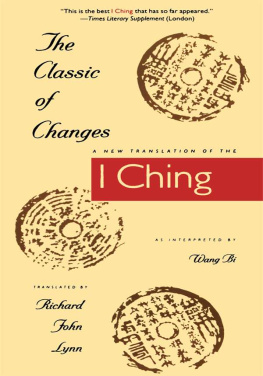

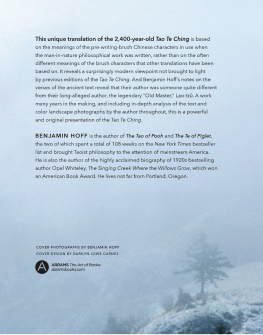
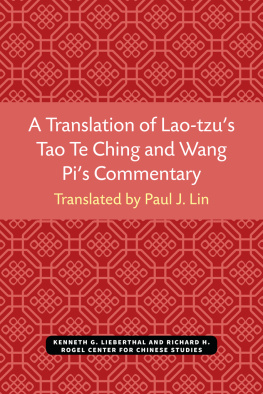
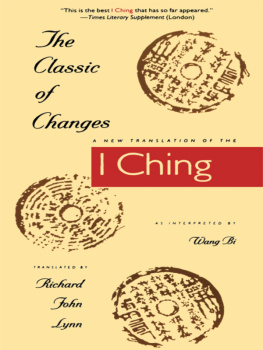
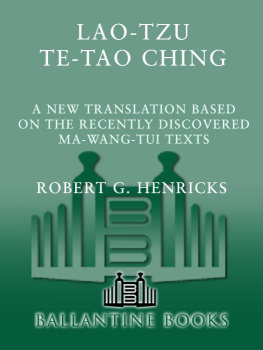
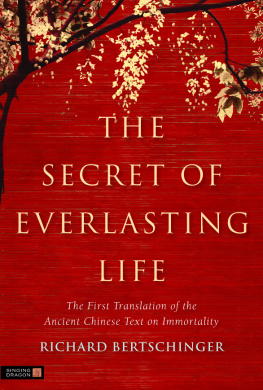
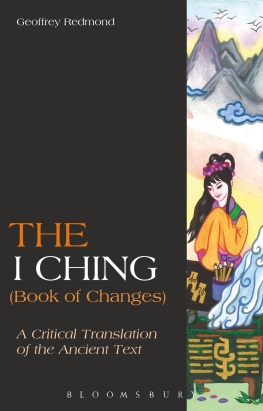
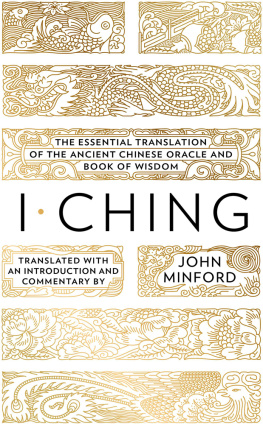


 ) or broken (yin
) or broken (yin  ). For example, Hexagram 59, Huan (Dispersion), is represented with the hexagram
). For example, Hexagram 59, Huan (Dispersion), is represented with the hexagram  : First Yin, Second Yang, Third Yin, Fourth Yin, Fifth Yang, Top Yangthe bottom trigram being Kan
: First Yin, Second Yang, Third Yin, Fourth Yin, Fifth Yang, Top Yangthe bottom trigram being Kan  and the top trigram being Sun
and the top trigram being Sun  . The combinations are determined by the numerical manipulation of divining sticks, originally yarrow stalks ( A chillea millefolium , also known as milfoil ) or, later, by the casting of coins. In the translation, each hexagram graph or schema appears at the head of the section devoted to the particular hexagram, immediately below the hexagram number.
. The combinations are determined by the numerical manipulation of divining sticks, originally yarrow stalks ( A chillea millefolium , also known as milfoil ) or, later, by the casting of coins. In the translation, each hexagram graph or schema appears at the head of the section devoted to the particular hexagram, immediately below the hexagram number.